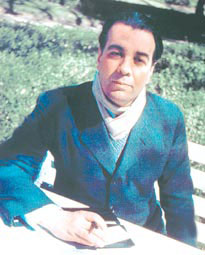“Little by little, a man comes to resemble the shape of his destiny; a man is, in the long run, his circumstances. Un hombre se confunde, gradualamente, con la forma de su destino; un hombre es, a la larga, sus circunstancias.”
“The Writing of the God”, La Escritura del Dios, is about a man in prison. Specifically, the man is an Aztec priest but it’s not really that relevant to the story. This is another one of those stories by Borges where you read the story not so much for the entertaining plot but for the meaning.
In the cell next to the prisoner is a tiger. Okay, at this point you know that you’re in a Borges story. Through a small opening in the wall the man can glimpse the tiger for a brief period every day. The man comes to believe that a message from god is written on the stripes of the tiger.
Borges raises a very interesting question in this story: “What sort of sentence, I asked myself, would be constructed by an absolute mind?” [¿Qué tipo de sentencia (me pregunté) construirá una mente absoluta?]
Borges was a strong agnostic. While he doesn’t attack conventional religions directly in this story, the question makes me wonder about the famous statements attributed to the Christian God through the words of Jesus…anyway, back to Borges.
“The Writing of the God” has other Borges characteristics, such as a dream within a dream within a dream. The prisoner eventually has a vision of God, an enormous Wheel made of water and fire. The Wheel was “made of all things that shall be, that are, and that have been, all intertwined, and I was one of the strands within that all-encompassing fabric.” [Entretejidas, la formaban todas las cosas que serán, que son y que fueron, y yo era una de las hebras de esa trama total].
Borges also makes a point of noting that evil is also part of that all-encompassing Wheel.
Through this vision the man comes to understand the writing on the tiger and that the man himself can become omnipotent, released from prison, and become immortal simply by speaking the words aloud. I’ll leave the conclusion of the story for you to read.
As I was re-reading the “The Writing of the God” the other night, I remembered the image of a divine Wheel that also exists in an essay by Borges. In “A New Refutatin of Time” Borges quotes from an Indian philospher on a 5th century Buddhist text: “Just as a rolling carriage wheel touches earth at only one point, so life lasts as long as a single idea.”
“A New Refutatin of Time” was written by Borges in the mid-1940s. We know from the Williamson biography that Borges spent several years composing “The Writing of the God”, which was published in the El Aleph collection in 1949. (Like many of Borges collected stories, the story might have first appeared in the magazine Sur but I don’t have the full chronology in front of me). So, the essay and the story are good companion pieces for reading.
In “A New Refutatin of Time”, the paragraph just before the mentioning of the Buddhist wheel is a quote from Schopenhauer, one of Borges favorite philosophers: “No man has ever lived in the past, and none will live in the future; the present alone is the form of all life, and is a possession that no misfortune can take away.”
Note: I’ve not yet verified that either of Borges quotes from the Visuddhimagga or Schopenhauer are accurate or yet another instance of Borges composing his own quotes; regardless, the statements are interesting.
 Yesterday I wrote about an essay by Borges titled Feeling in Death. A good companion piece to that essay is the poem The Cyclical Night, La noche ciclica. The poem expresses many of the same sentiments as Feeling in Death:
Yesterday I wrote about an essay by Borges titled Feeling in Death. A good companion piece to that essay is the poem The Cyclical Night, La noche ciclica. The poem expresses many of the same sentiments as Feeling in Death: